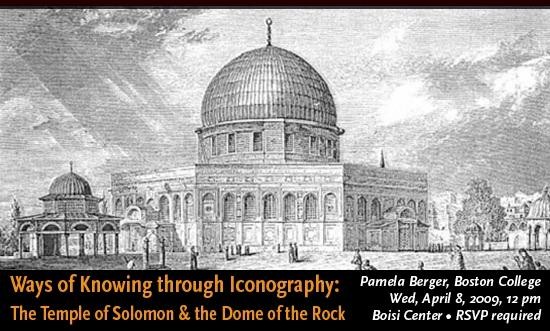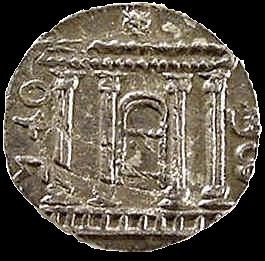Ways of Knowing through Iconography: The Temple of Solomon and the Dome of the Rock

Pamela Berger
Boston College
Date: April 8, 2009
Abstract
The Dome of the Rock figured as a model for the Temple of Solomon in some works of art. However, the depth and complexity of the connection has not been explored, nor has the meaning of that domed structure in Jewish art been illuminated. Pamela Berger's research shows how the site of the rock retained its holiness as it was re-consecrated first by Muslims, then by Christians, then by Muslims again. The way Berger views the material is completely new for the field, especially the idea that the Muslims built upon a site holy to Jews and recognized its importance for their common ancestors, David and Solomon. This perspective points to links that have been ignored in modern scholarship, especially since the mid-twentieth century. The material Berger presents will encourage people to look at the history of this site in a new way, not as a monument with an importance for one group only, but as a shrine which, at different times in its history, was viewed as a sacred place by the three Abrahamic faiths.
Speaker Bio

Pamela Berger is a filmmaker who has written, produced and/or directed three feature films. “Sorceress” is about a medieval woman who is accused of being a heretic but is actually a healer. It was shot in both English and French. Both versions are now available on DVD.
The second film, which she wrote, produced and directed is “The Imported Bridegroom.” It’s a comedy set in Boston in 1900 about a father who tries to find, back in the Old Country, a perfect bridegroom for his Americanized daughter. She takes one look at the boy he brings back and is appalled. This film is also in DVD.
The third film, “Kilian’s Chronicle: The Magic Stone” is about an Irish slave who escapes from a Viking ship and is rescued by Native Americans five hundred years before the arrival of Columbus.
Professor Berger teaches medieval art, from 300 to 1425 CE. Her special interest is iconography, i.e. the meaning of the image in the context of its time, and most of her research deals with iconographic interpretation.
Event Recap
During her April 8 presentation at the Boisi Center, Pamela Berger, Professor of Fine Arts, explored the iconographic relationship between the Temple of Solomon and the Dome of the Rock. Berger’s interest in this topic arose when she noticed that in medieval art the Temple was often depicted as circular, even though it is known to have been rectilinear both when built by Solomon and when rebuilt by Herod.
Even after the destruction of the Second Temple, Jews, who were expelled from Jerusalem, would return to the city and conduct furtive ceremonies at the site of a pierced stone where they believed the Holy of Holies had stood. Under Christian rule the land eventually became part of a garbage dump and was defiled. When Muslim armies captured the city in 636 CE, their leader, Umar, sought out the holy rock. By now it had been legendarily connected to Abraham’s near sacrifice of Isaac (according to Jews and Christians) or Ishmael (according to Muslims), Jacob’s pillow and the site where David prayed asking for God’s mercy while his first child with Bathsheba was dying.
The Dome of the Rock was erected as a large circular building on the site, and Muslims tolerated Jewish worship there. Berger showed examples of how this round Muslim building was iconographically conflated by Christian crusaders, as well as Jews, with the Temple of Jerusalem. She hopes this art historical conversation will encourage greater interreligious dialogue.
Read More
Further Reading
Allen, H. R.,“The Original Appearance of the Dome of the Rock, Bayt al-Maqdis.” Bayt Al-Maqdis. Ed. Jeremy Johns. Oxford Studies in Isalmic Art. IX Part Two. Oxford: Oxford University Press. (1999): 107 – 213
Benjamin of Tudela, in Thomas Wright. ed. Early Travels in Palestine. New York: AMS Press. Reprint. 1969.
Busse, Heribert. “Vom Felsendom zum Templum Domini.” Das Heiligen Land im Mittlealter. Ed. Wolfdietrich Fischer and Juergen Schneider. Neustadt an der Aisch: Verlag Degener & Co., 1982. 19 – 32.
Busse, Heribert. “Umar’s Image as the Conqueror of Jerusalem.” Jerusalem Studies in Arabic and Isalm. 8, (1986): 149 – 168, [esp., p. 165, note 42 p. 149ff]CHECK
Busse, Heribert. “The Destruction of the Temple and its Reconstruction in the Light of Muslim Exegesis of Sura 17:2 – 8.” Jerusalem Studies in Arabic and Islam. 20 (1996): 1 – 17.
Busse, Heribert. “The Temple of Jerusalem and its Restitution by ‘Abd al_Malik B. Marwan. Real and Ideal Jerusalem in Jewish, Christian and Islamic Art. Ed. Bianca Kühnel. Jerusalem: The Hebrew University of Jerusalem, 1998. 23-33.
Creswell, K. A. C.. Early Muslim Architecture. Vol I, Part I. New York: Hacker Art Books, 1979.
Elan, Amikam. “Why Did ‘Abd al-Malik Build the Dome of the Rock? A re-examination of the Muslim Sources,” Bayt la-Maqdis, ‘Abd al-Malik’s Jerusalem. Julian Raby and Jeremy John, eds. Part One. Studies in Islamic Art, vol IX. Oxford: Oxford University Press. 1992, 33 – 58.
Ferber, Stanley. “The Temple of Solomon in Early Christian and Byzantine Art.” The Temple of Solomon. Joseph Gutmann, ed. Missoula, Mont: Scholars Press, 1976. 21-44.
Folda, Jaroslav. Crusader Art in the Holy Land. Cambridge: Cambridge University Press, 2005.
Grabar, Oleg. “The Umayyud Dome of the Rock.” Art Orientalis. (1959) 33 – 62.
Grabar, Oleg. The Shape of the Holy. Princeton: Princeton University Press, 1996.
Hirschberg,J. W.. “The Sources of Moslem Traditions concerning Jerusalem.” Rocznik Orientalistyczny. 17 (1951): 314 – 350.
Jacobson, David M., “Ideas Concerning the Plan of Herod’s Temple,” Palestine Exploration Quarterly, (1980): 33 – 40.
“Itinerarium Bernardi Monachi.”. In Itinera hierosolymitana et descriptiones Terrae Sanctae , Titus Tobler, ed. 1806-1877, 314.
Josephus, Antiquities of the Jews, Book 15, ch. 11 [http://www.sacred-texts.com/jud/josephus/ant-15.htm#EndNote%20Ant%2015.23a]
Josephus, Jewish Wars, Jewish Encyclopedia on line. http://www.jewishencyclopedia.com/view.jsp?artid=123&letter=T&search=temple%20and%20herod
Krinsky, Carol Herselle. “Representations of the Temple of Jerusalem before 1500.” Journal of the Warburg abnd Courtauld Institutes33 (1970): 1 – 19.
Krautheimer, Richard. “Iconography of Mediaeval Architecture.” Journal of the Warburg and Courtauld Institutes. 5 (1942): 1 – 33.
Kuëhnel, Bianca. “Jewish Symbolism of the Temple and the Tabernacle and Christian symbolism of the Holy Sepulchre and the Heavenly Tabernacle.” Jewish Art. (1987): 147 – 68
Kuëhnel, Gustav. “Aachen, Byzanz und Die Fruehislamische Architektur im Heiligen Land.” Studien zur byzantinischen Kunstgeschichte: Festschrift Für Horst Hallensleben zum 65 Geburstag. Birgitt Borkopp et al. Editors. Amsterdam: Verlag Adolf M. Hakkert, (1995): 39-57.
Lewis, Bernard. “An Apocalyptic Vision of Islamic History.” Bulletin of the School of Oriental and African Studies. 13 (1950): 308 – 338.
Le Strange, Guy. Palestine Under the Moslems. Beirut:Khayats, 1965.
Maimonides, The Code of Maimonides, Book Eight, The Book of Temple Service. translated with an introduction by Mendell Lewittes. New Haven, Conn: Yale University Press, 1957.
Mayer, Hans Eberhard. Das Siegelwesen in den Kreuzfahrerstaaten. Munich: Verlag der Bayerischen Akademie der Wissenschaften, 1978.
Mishna, Tractate Middoth. http://www.sacred-texts.com/jud/t03/yom10.htm
Naredi-Rainer, Paul von. “Between Vatable and Villalpando: Aspects of Postmedival Reception of the Temple in Christian Art.” Real and Ideal Jerusalem in Jewish, Christian and Islamic Art. Ed. Bianca Kühnel. Jerusalem: The Hebrew University of Jerusalem, 1998. 218 – 225.
Naredi-Rainer, Paul von. Solomos Tempel und das Abendland. Köln: Dumont Buchverlag, 1994.
Petachia, [Pethahiah of Regensburh] Rabbi Yehoodah the Pious. Travels of Rabbi Petachia of Ratisbon. Translated and abridged by Abraham Benish. London: Trubner, 1856.
Peters, F. E.. Jerusalem. Princeton: Princeton University Press, 1985.
Rabbat, Nasser. “The Meaning of the Umayyad Dome of the Rock.” Muqarnas 6 (1989): 12 – 21.
Rashi, Commentary on the Bible: http://www.chabad.org/library/article_cdo/aid/63255/jewish/The-Bible-with-Rashi.htm
Rosenblatt, Samuel. “Rabbinic Legends in Hadith,’ The Moslem World. 35 (1945): 237 – 252.
Sabar, Shalom. “Messianic Aspirations and Renaissance Urban Ideals: The Image of Jerusalem in the Venice Haggadah, 1609.” Real and Ideal Jerusalem in Jewish, Christian and Islamic Art. Ed. Bianca Kühnel. Jerusalem: The Hebrew University of Jerusalem, 1998. 294 – 312.
Sed-Rajna, Gabrielle. “Images of the Tabernacle/Temple in Late Antique and medieval Art: The State of Research,” Real and Ideal Jerusalem in Jewish, Christian and Islamic Art. Ed. Bianca Kühnel. Jerusalem: The Hebrew University of Jerusalem, 1998.
42 – 53.
Sed-Rajna, Gabrielle. “The Illustrations of the Kaufmann Mishneh Torah,” Journal of Jewish Art. (1979): 64 – 77.
Sharon, Moshe. “The ‘Praises of Jerusalem’ as a Source for the Early History of Islam.” Bibliotheca Orientalis. 49. No.1/ 2 (1992): 56 – 68.
Silver, Larry. “Mapped and Marginalized: Early Printed Images of Jerusalem.” Real and Ideal Jerusalem in Jewish, Christian and Islamic Art. Ed. Bianca Kühnel. Jerusalem: The Hebrew University of Jerusalem, 1998. 313-324.
Soucek, P.,“The Temple of Solomon in Islamic Legend and Art,” The Temple of Solomon, Joseph Gutmann, ed. Missoula, Mont: Scholars Press, 1976. 73-124.
Suermann, H.. “Muhammad in Christian and Jewish Apocalyptic Expectations.” Islam and Christian-Muslim Relations. 5. 1(1994): 15 – 21.
Talmud, Tractate Yoma V: Babylonian Talmud, Book 3: Tractate Yoma, http://www.sacred-texts.com/jud/t03/yom10.htm [tr. by Michael L. Rodkinson, [1918], at sacred-texts.com Chapter V, page 76, In Jewish Virtual Library, “Regulations concerning the remaining services of the high-priest on this day in the times of the First and Second Temples.” http://www.jewishvirtuallibrary.org/jsource/Talmud/yoma5.html
Vilnay, Zev. Legends of Jerusalem. Philadelphia: The Jewish Publication Society of America, 1973.
Weiss, David. “Hec est Domus Domini firmiter edificata: The Image of the Temple in Crusader Art.” Real and Ideal Jerusalem in Jewish, Christian and Islamic Art. Ed. Bianca Kühnel. Jerusalem: The Hebrew University of Jerusalem, 1998. 210 – 217.
Weitzmann, Kurt. “The Question of the Influence of Jewish Pictorial Sources on Old Testament Illustration.” Studies in Classical and Byzantine Manuscript Illumination, Chicago: University of Chicago Press, 1971. 76 - 95
Weitzmann, Kurt. Die Byzantinische Buchmalerei des 9. Und 10. Jahrhunderts. Vol. I. Wien: Verlag des Oesterreichischen Akademie der Wissenschaften, 1996.
Weitzmann, Kurt and Massimo Bernabò, The Illustrations in the Manuscripts of the Septuagint II. Octateuch. TEXT & PLATES. Princeton: Princeton University Press, 1999.
Wilkinson, John. Jerusalem Pilgrims before the Crusades. Warminster: Aris & Phillips Ltd, 2002.
Wilkinson, John. Jerusalem Pilgrimage 1099 – 1185. London: The Hakluyt Society, 1988.
Wright, Thomas. ed. Early Travels in Palestine. New York: AMS Press. Reprint. 1969.
Yerushalmi, Yosef Hayim. Haggadah and History. Philadelphia: The Jewish Publication Society of America, 1975.

